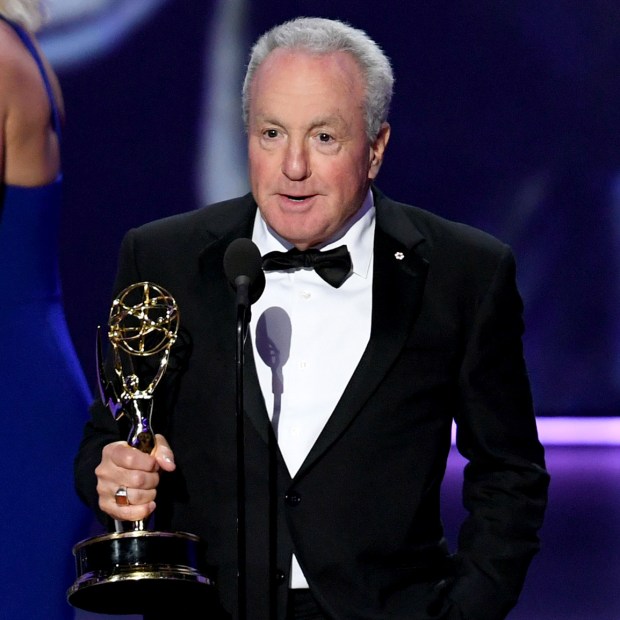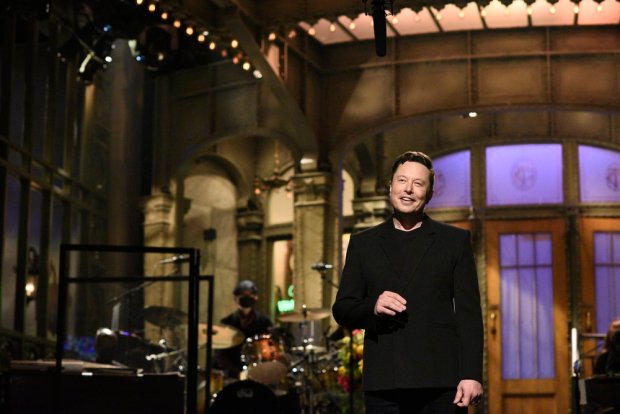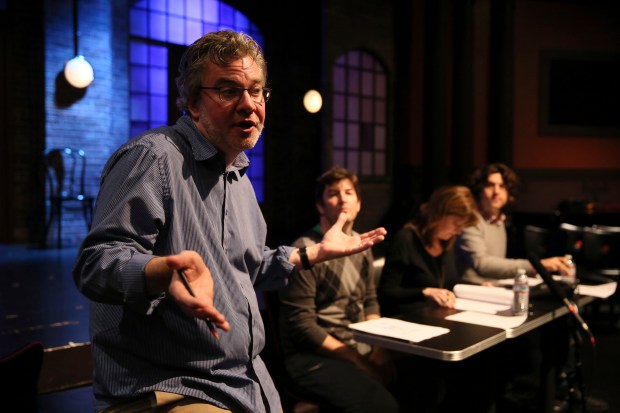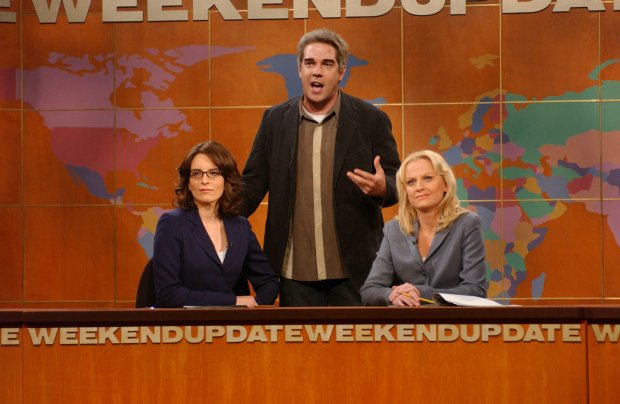Thirty thoughts on “Saturday Night Live” are too few.
There’s too much lore, too many feelings, too much to celebrate and far too much to complain about. Yet like “SNL” itself, tasked weekly with delivering more than it can accomplish in 90 minutes, 30 will have to do. Not even NBC’s splashy three-hour 50th anniversary extravaganza on Sunday can hold it all: You’ll likely get a glimpse of the very first sketch from the very first episode, on Oct. 11, 1975, a quick segment that marked the national debut of an Albanian native from Wheaton named John Belushi.
(No. 1) But you will probably not hear that “Saturday Night Live” was just “Saturday Night” for its first two years. “Live” came later, after some red tape was ironed out and enough time passed to erase memories of ABC’s 1975 show “Saturday Night Live with Howard Cosell” (also featuring a Chicagoan named Bill Murray).
(No. 2) “TV in 1975 was still lagging about 20 years behind the rest of the culture,” said Susan Morrison, an editor at the New Yorker and author of “Lorne,” a new biography of “SNL” creator Lorne Michaels. “Music was starting to see punk, movies had Robert Altman and John Cassavetes, but TV was still stuck in the 1950s. … You’d have a Bob Hope variety that would make fun of stoned hippies and the actors just acted drunk because you had old staffs.”
(No. 3) Contempt for TV was so ingrained among the hip that Steve Martin, on the writing staff for “The Smothers Brothers Comedy Hour,” came up with a genius epitaph: “It has been proven that more Americans watch television than any other appliance.”
(No. 4) As much as “SNL” now represents a mainstream, meme-friendly sensibility, it was partly conceived as ‘70s conceptual art taking a hammer to the creaky old network variety show. Michaels, who had a history with Toronto art schools, signaled this early, making sure that Andy Kaufman (lip-synching to the “Mighty Mouse” theme) was on the first episode. His love for the conceptual has been illustrated more recently in a pair of former Chicagoans, Fred Armisen and Sarah Sherman, the latter of whom was hired after her hilariously disgusting weekly Hideout performances.
(No. 5) Besides “SNL,” we also got “Jaws,” Springsteen’s “Born to Run” and Patti Smith in 1975.
(No. 6) Those four milestones, for many kids, made up a 1970s childhood. “SNL” was your elementary-school gateway into an edgier culture. (Assuming you were allowed to stay up.) “SNL” was what you talked about at recess, despite understanding only a fraction. I did not get Laraine Newman’s famous line — “Look, the shiksa’s making us a Presbyterian pie!” — still, I laughed and have never forgotten it.
(No. 7) The show’s influence on American movies and comedy and music and politics can’t be overstated, but its impact on the reputation of Chicago goes even deeper. The other day, Kelly Leonard, who had been one of Second City’s artistic leaders and producers for nearly 30 years, told me: “I was just going through a list of alumni who went to ‘SNL’ from Second City, and seriously, it’s exactly 50 people. When I first came to Second City in the 1980s, the lore was twofold: First, our relationship with ‘SNL,’ our role as a conduit for talent to the show, had put Second City into a new, national spotlight, though secondly, (older administrations) watched the show with a wary eye — they saw the show as somewhat of a drain on Chicago talent.”
(No. 8) The talent pipeline from Chicago to “SNL” has been unmatched (with occasional challenges from Los Angeles and the Harvard Lampoon), a tap that runs through Second City, iO Theater and Annoyance Theatre. Even a partial list must include John Belushi, Dan Aykroyd, Bill Murray, Tim Meadows, Tina Fey, Amy Poehler, Tim Kazurinsky, Nora Dunn, Chris Farley, Beck Bennett, Alex Moffat, Jason Sudeikis, Chris Redd, Cecily Strong, Sarah Sherman, Aidy Bryant, Fred Armisen, Julia-Louis Dreyfus, Horatio Sanz, Rachel Dratch and Vanessa Bayer.
(No. 9) On the list that Leonard made of Second City alum who left for “SNL,” about half were hired as writers. Indeed, several famous performers began at “SNL” as writers, including Tina Fey, Jason Sudeikis and Tim Robinson. Chicago’s John Mulaney, too. Chicago’s Hannibal Buress was a writer for one disappointing year. Naperville’s Bob Odenkirk, who became a celebrated performer after leaving “SNL,” was one of the show’s main writers in the early 1990s. (Most famously, he wrote the “van down by the river” sketch for Chris Farley.)
(No. 10) There is also a lot of Chicago-bred talent that remained behind the camera. Adam McKay (who later became a director, making a string of blockbusters with Will Ferrell, including “Anchorman” and “Step Brothers”) was an “SNL” head writer. Claire Mulaney (yes, sister of John) was an “SNL” writer. Jim Downey, a Joliet native, began as a writer in 1976 and remained a key “SNL” architect and producer (particularly of political jokes and “Weekend Update”) for almost 40 years.
(No. 11) At some point during the anniversary special, someone will make a joke about the show not being as good as it used to be — a hot take that dates to roughly 1975. In the handful of histories of the show, Michaels reiterates the lifecycle: Every two years, the show is deemed “dead,” then “revived,” then “on life support,” then “better than ever,” then “worse than ever.” As many have noted, “SNL” was always at its best whenever you were in high school.
(No. 12) Regardless of age, there is likely a cast member that you can not understand how they got on this show? Myself, I was slow to warm to Kate McKinnon. Same with Kenan Thompson (too muggy). To this day, Dana Carvey seems lifted from exactly the sort of corny network TV that “SNL” revolted against.
(No. 13) You especially can’t understand how your least favorite cast member was hired after you know the secret history of who auditioned but did not get cast. Some rejected the show themselves: Mindy Kaling was offered a writing job but wanted to be a performer. Jordan Peele couldn’t get out of a Fox contract. Still, the rejects are legion: Amy Sedaris, Tiffany Haddish, Jim Carrey, Nick Kroll, Aubrey Plaza, John Goodman, Geena Davis, Jennifer Aniston, Andrea Martin, Zach Galifianakis, Paul Reubens. Members of the Chicago-based theater company Team StarKid. Kevin Hart, Ellie Kemper and Donald Glover — all auditioned and were rejected on the same day.

(No. 14) Morrison’s biography “Lorne” is the most thorough explainer of why weak jokes happen to funny people and terrible shows occur despite strong casts. “You realize what is funniest is not the main criteria,” said Morrison, who sat through a full week of production. “Sometimes it’s physical constraints of a set, or difficulty with costuming, or a host doesn’t like a good sketch. There is a ruthlessness that governs decisions.”
(No. 15) One skill that cast members develop is the ability to get through their lines without many pauses or dramatic holds — every second wasted is deducted from the remainder of the show. A few too many pauses and entire sketches are scrapped.
(No. 16) Because dress rehearsals are taped, a fascinating repository of material that was killed between the rehearsal and the live show gets posted to a YouTube channel, “Cut for Time Sketches on SNL.” A recent Paul Mescal sketch about Irish ancestry is so uproarious, it’s painful to know it didn’t make the cut.
(No. 17) Everyone has an “SNL” sketch they can’t shake. Mine is a Will Ferrell sketch about the first Thanksgiving, in which Ferrell (playing a Native American elder) doesn’t trust a white guest, colonist John Smith. (“I’m just saying, since those illegals showed up a lot of things have gone missing lately — buffalos, land …”) A close second is a talent show sketch from 1975, “Death Row Follies.” Garrett Morris, as a prisoner, gets up and belts out: “I’m going to get me a shotgun and kill all the whities I see…” (Yes, I sang it during an elementary school recess. And no, it did not go over quite as well at school.)
(No. 18) Any longtime fan of “SNL” eventually runs into the problem of outlasting their youth. There’s real disappointment in introducing a younger person to a favorite sketch from your past and watching them not even crack a smile.
(No. 19) Identifying the initial spark for “SNL” is murky. Composer Howard Shore, the first musical director, said it came from shows he and Michaels did at summer camp as children. Others say it sprung out of “The Hart and Lorne Terrific Hour,” a Canadian TV show Michaels did with an early partner, Hart Pomerantz. Some say it was a natural extension of the writing Michaels did for “Laugh-In,” then TV specials he made with Lily Tomlin.
(No. 20) Michaels often described his concept for “SNL” as somewhat in line with what Monty Python was doing in England. When he began pitching the show, he would show TV executives episodes of “Monty Python’s Flying Circus,” still a nascent TV import in 1975. He hooked on to the phrase “And now for something completely different” as the “SNL” motto. He met the first cast member that he hired (Chevy Chase) when they were in line to see “Monty Python and Holy Grail.” And for a short time, “SNL” blatantly ripped off “Monty Python’s Flying Circus.” In the first season, when jokes went flabby or the writers didn’t know how to finish a skit, a fake cow was dropped from the rafters.
(No. 21) Late in the 1975 season, as the show gathered steam, Michaels famously offered to pay The Beatles $3,000 to reunite on “SNL.” Two legends came out of that: The first is that John Lennon and Paul McCartney seriously thought of taking him up on the offer. Though Lennon once told Playboy they were close to going, McCartney told an interviewer in 2020 that they had discussed going to “SNL” the following Saturday, not realizing the show was on a break that night. The other legend is the $3,000 check was a joke, an intentionally laughable amount. In fact, $3,000 was the most Michaels could get NBC to offer.
(No. 22) If there’s a recipe for a good “SNL” host, the main ingredients are: A serious acting resume and willingness to remain as knowingly serious as possible (Ryan Gosling, Natalie Portman, Timothée Chalamet, Christopher Walken, Adam Driver). Or they are relatively minor celebrities when they first host (Steve Martin, Emma Stone) with latent, generous, all-for-one comic abilities that could make them cast members.
(No. 23) Some famous people who never hosted: Jack Nicolson (despite being a close friend of Michaels’), Woody Allen, Tom Cruise, Leonardo DiCaprio and Meryl Streep. Diana Ross and Muhammad Ali turned down the show in the 1970s. So did Richard Nixon. Andy Warhol, Morrison writes, would do it if he could replace the cast with his own actors.

(No. 24) Worst host ever? This history is bottomless, so let’s stick to a few of the most hated by cast members: Justin Bieber (and his vast entourage) was not appreciated. Elon Musk made Chloe Fineman cry. Whenever Michaels asked Milton Berle to deliver his lines less broadly, Uncle Miltie patted Michaels on the shoulder and said, “I know, I know — satire.’” Frank Zappa was so bullying when he appeared that the cast avoided him, and Steven Seagal was so unexpressive and humorless that, not long after he hosted, Michaels himself said on the air that Seagal was the biggest jerk to ever host.
(No. 25) The first Black female cast member was Chicagoan Danitra Vance. She grew up in the Princeton Park Homes on the South Side and Markham. She taught school in Gary and was a regular in Chicago theater, then off-Broadway. At the same time, she was honing characters at Second City and Zanies. She was hired for the 1985 season, then fired along with most of the cast that season (including Joan Cusack). Her best-known character was Miss Cabrini-Green Harlem Watts Jackson. She was one of the first LBGTQ cast members, which wasn’t widely known until she died in 1994.
(No. 26) Katie Caussin, artistic director at Chicago’s iO, said: “Every improv performer in Chicago has a story where they come off stage and meet an audience member who asks: ‘When am I going to see you on “SNL”?” At least once a year, “SNL” producers (and sometimes Michaels himself) swing through Chicago on a hunt for new talent. They have for decades. Second City’s Leonard said: “One of the things you have to tell young talent is if their eyes are just on the next thing, if they’re too focused on ‘SNL,’ they’re going to miss ‘SNL’ — and they’re not going to get anything out of Second City.”

(No. 27) Rumor has it that no one from “SNL” laughs during those auditions. But Lindsay Shookus, a former “SNL” producer who left the show in 2022, said that’s nonsense. “Lorne would say, ‘Why do people think this? I laugh!’ We love to laugh. I remember one trip coming back from Chicago where we saw so much talent all at once — Cecily Strong, Aidy Bryant, Tim Robinson. That was just one trip. But you don’t give cheap laughs when you spend so much time around comedy. You get comedy overload, so it tends to take someone special to stand out.”
(No. 28) According to “Lorne,” though it’s common knowledge Michael Myers based his Dr. Evil character from the “Austin Powers” movies on the vocal mannerisms and aloofness of Michaels, Dana Carvey says (with a passing annoyance) that Myers lifted much of his Lorne impression from the way Carvey would spend some of the backstage downtime imitating Michaels.
(No. 29) Most “SNL” histories insist Michaels takes pains to be politically nonpartisan. Shookus said, “Because it’s New York and there are so many liberals, he wants more than one side. George W. Bush and Trump were easier than Obama to make fun of. Clinton was easier. We had Jim Carrey doing Biden but the joke was always he’s old. People have a hard time believing it but Lorne likes to say the show goes out to all 50 states.”
(No. 30) Michaels began the show when he was 30. He turned 80 last November. Who will replace him has been a longtime parlor game among fans (and staff) of the show. Tina Fey would seem ideal. “But I think Tina likes having a life,” Morrison said. She thinks only Seth Meyers (“or perhaps Colin Jost”) have the temperament for the role. “But really, I think Lorne is the heart and soul and I really don’t imagine seeing him ever retiring.”
The end of “Saturday Night Live” has been predicted, and hoped for, and feared, so often, it’s worth mentioning the show itself has concluded at least two seasons on intentionally melancholy cliffhangers: The reviled 11th season ended with a faux cleansing fire in the studio and a question: Who would survive? The saddest though was the conclusion of the fifth season, in spring 1980. The original cast, at long last, had finally splintered, and Michaels himself had not yet made a decision about the future.
The last thing audiences saw that season was a shot of the ON AIR sign outside Studio 8H at 30 Rockefeller Plaza. It sputtered, flickered and went dark. Everyone assumed it was the end.
Instead, it was just another beginning.
“SNL 50: The Anniversary Special” airs at 7 p.m. CT Sunday on NBC and streamed on Peacock; www.nbc.com
cborrelli@chicagotribune.com



